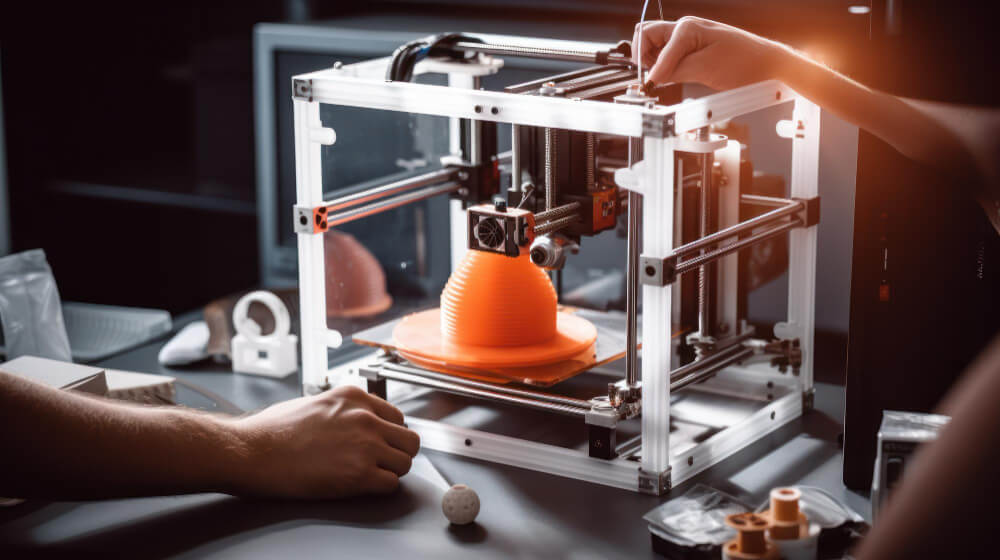
In recent years, 3D printing has emerged as a groundbreaking technology, revolutionizing how we manufacture and create objects. It has revolutionized industries, from manufacturing to medicine, and it continues to push the boundaries of what we thought possible.
From simple prototypes to intricate designs, 3D printers can transform digital models into physical objects with astonishing precision. But how does a 3D printer work? In this blog, we will delve into the inner workings of 3D printers and explore the different processes involved in bringing a design to life.
The Art Of 3D Printing And How Does A 3D printer work

3D printing, also known as additive manufacturing, is a process that creates a physical object from a digital model by laying down many thin layers of material. The “print” is built up layer by layer until the final product is complete. Take a look at how does a 3D printer work:
1. Computer-Aided Design (CAD) Software
The journey of a 3D-printed object begins with a digital model created using computer-aided design (CAD) software.
This software allows designers to create intricate and complex designs with ease. Once the design is complete, it will be sent to the 3D printer for fabrication.
2. Slicing
Before 3D printer working can begin, the digital model must be sliced into thin layers. This process is crucial as it determines the final product’s level of detail and accuracy.
Slicing software breaks down the digital model into thousands of horizontal layers, each representing a cross-section of the object.
3. Printing Materials
3D printers can work with various materials, including plastics, carbon fibers, conductive materials, and metals. The choice of material depends on the desired properties of the final object.
For example, a metal or carbon fiber material may be used if strength and durability are essential. On the other hand, if flexibility and affordability are the priorities, plastic materials are commonly utilized.
4. 3D Printing Process Types
There are several different 3D printing processes, each with unique advantages and applications. Let’s take a look at some of the most common ones:
Fused Deposition Modeling (FDM): This is the most common type of 3D printing technology. It uses a thermoplastic filament, which is heated to its melting point and then extruded, layer by layer, to create a 3D object. FDM is widely used due to its affordability and ability to build solid and functional parts. Stereolithography (SLA): SLA uses a light-sensitive liquid resin. A UV laser beam is used to harden the resin, layer by layer, to create a solid object. This process allows for high-level precision and is often used in industries such as dentistry and jewelry making. Selective Laser Sintering (SLS): SLS utilizes a laser to selectively fuse powdered materials, such as nylon or metal, layer by layer, binding them together to create a solid structure. It is known for its ability to create complex geometries and is commonly used in industrial applications.
5. Printing Process
To know how a 3D printer works, 3D printing begins with a digital 3D model, a CAD (Computer-Aided Design) file, or a scanned 3D model. This digital design acts as a blueprint for the 3D printer.
Once the design is ready, it’s “sliced” into hundreds or thousands of horizontal layers using slicing software. The printer uses a hot nozzle or precision tool to dispense the material layer by layer according to the instructions from the sliced model.
This slicing process translates the 3D model into a series of 2D layers, essentially a roadmap for the 3D printer to follow. The printer then reads this sliced data, laying down successive layers of material until the 3D object is created.
Depending on the size and complexity of the design, this process could take hours or even days to complete.
6. Post-Processing
After the printing, the object may require post-processing to remove any support structures, smooth rough surfaces, or add finishing touches.
This step ensures the final product meets the desired specifications and aesthetics.
The Future Of 3D Printing

The potential applications for 3D printing are endless. From creating custom prosthetics in the medical field to rapid prototyping in manufacturing, 3D printing is a game-changer. We can only expect to see even more incredible advancements in this field as technology evolves.
Conclusion
The world of 3D printing is exciting, filled with endless possibilities. By transforming digital models into physical objects, 3D printers are truly revolutionizing industries and changing how we think about production. By understanding the process behind 3D printing, we gain a deeper appreciation for the technology’s potential and endless possibilities. Whether in medicine, architecture, or even art, 3D printing continues to push the boundaries of what is possible, opening up a world of innovation and creativity.
Leave a Reply